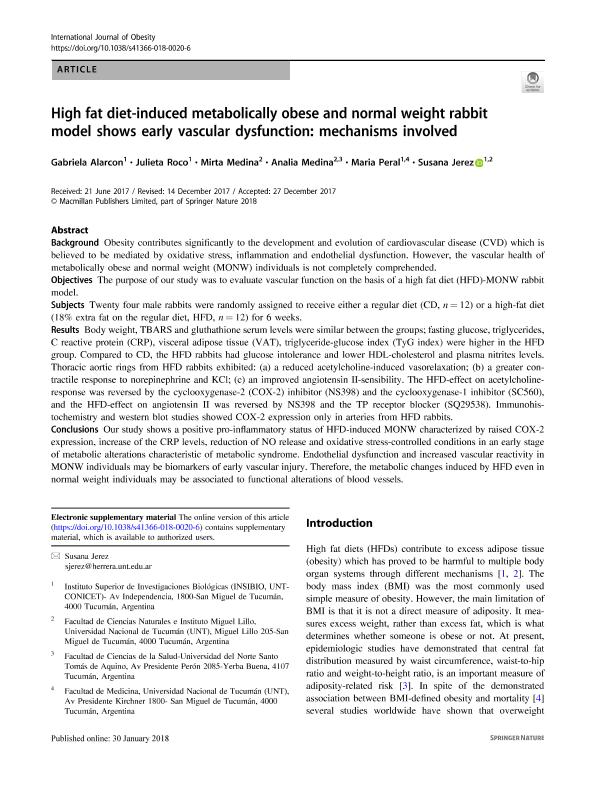Artículo
High fat diet-induced metabolically obese and normal weight rabbit model shows early vascular dysfunction: mechanisms involved
Alarcón, Gabriela del Jesús ; Roco, Julieta
; Roco, Julieta ; Medina, Mirta; Medina, Analía de Los Angeles; Peral, Maria de Los Angeles
; Medina, Mirta; Medina, Analía de Los Angeles; Peral, Maria de Los Angeles ; Jerez, Susana Josefina
; Jerez, Susana Josefina
 ; Roco, Julieta
; Roco, Julieta ; Medina, Mirta; Medina, Analía de Los Angeles; Peral, Maria de Los Angeles
; Medina, Mirta; Medina, Analía de Los Angeles; Peral, Maria de Los Angeles ; Jerez, Susana Josefina
; Jerez, Susana Josefina
Fecha de publicación:
09/2018
Editorial:
Nature Publishing Group
Revista:
International Journal Of Obesity
ISSN:
0307-0565
e-ISSN:
1476-5497
Idioma:
Inglés
Tipo de recurso:
Artículo publicado
Clasificación temática:
Resumen
Background: Obesity contributes significantly to the development and evolution of cardiovascular disease (CVD) which is believed to be mediated by oxidative stress, inflammation and endothelial dysfunction. However, the vascular health of metabolically obese and normal weight (MONW) individuals is not completely comprehended. Objectives: The purpose of our study was to evaluate vascular function on the basis of a high fat diet (HFD)-MONW rabbit model. Subjects: Twenty four male rabbits were randomly assigned to receive either a regular diet (CD, n = 12) or a high-fat diet (18% extra fat on the regular diet, HFD, n = 12) for 6 weeks. Results: Body weight, TBARS and gluthathione serum levels were similar between the groups; fasting glucose, triglycerides, C reactive protein (CRP), visceral adipose tissue (VAT), triglyceride-glucose index (TyG index) were higher in the HFD group. Compared to CD, the HFD rabbits had glucose intolerance and lower HDL-cholesterol and plasma nitrites levels. Thoracic aortic rings from HFD rabbits exhibited: (a) a reduced acetylcholine-induced vasorelaxation; (b) a greater contractile response to norepinephrine and KCl; (c) an improved angiotensin II-sensibility. The HFD-effect on acetylcholine-response was reversed by the cyclooxygenase-2 (COX-2) inhibitor (NS398) and the cyclooxygenase-1 inhibitor (SC560), and the HFD-effect on angiotensin II was reversed by NS398 and the TP receptor blocker (SQ29538). Immunohistochemistry and western blot studies showed COX-2 expression only in arteries from HFD rabbits. Conclusions: Our study shows a positive pro-inflammatory status of HFD-induced MONW characterized by raised COX-2 expression, increase of the CRP levels, reduction of NO release and oxidative stress-controlled conditions in an early stage of metabolic alterations characteristic of metabolic syndrome. Endothelial dysfunction and increased vascular reactivity in MONW individuals may be biomarkers of early vascular injury. Therefore, the metabolic changes induced by HFD even in normal weight individuals may be associated to functional alterations of blood vessels.
Palabras clave:
DYSFUNTION
,
VASCULAR
,
OBESITY
,
RABBIT
Archivos asociados
Licencia
Identificadores
Colecciones
Articulos(INSIBIO)
Articulos de INST.SUP.DE INVEST.BIOLOGICAS
Articulos de INST.SUP.DE INVEST.BIOLOGICAS
Citación
Alarcón, Gabriela del Jesús; Roco, Julieta; Medina, Mirta; Medina, Analía de Los Angeles; Peral, Maria de Los Angeles; et al.; High fat diet-induced metabolically obese and normal weight rabbit model shows early vascular dysfunction: mechanisms involved; Nature Publishing Group; International Journal Of Obesity; 42; 9; 9-2018; 1535-1543
Compartir
Altmétricas



